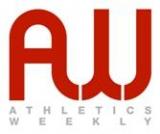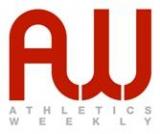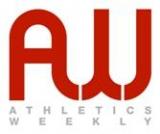Folders |
Sprint start tips and drillsPublished by
Tony Lett explains how club sprinters can make sure they get out of their blocks quickestIn a sprint, at the starter s command, an athlete takes up a position with their hands just behind the line, arms vertical and feet placed to their best advantage generally about a shoe length apart. In the set” position, it is generally understood that the hips should rise above the line of the head. However, this is where things can go wrong, following the misguided concept that they must also lean forward, bringing the shoulders ahead of the hands and putting pressure on them. This can easily be checked in practice and made visible to the athlete by using a stick or weighted string to drop down from the shoulders. When the gun goes, it becomes impossible to instantly drive the arms forward or backward without first lifting them off the ground, and like the middle-distance runner, they can lose vital fractions of a second. However, keeping the shoulders above the hands while still raising the hips places a lot more load on to the feet, where it should be, next to the ground, allowing the arms to react more quickly. Once this position is established, the coach can look at the leg angles, which may be different from when using the forward lean, and may require moving the block settings to return to the standard of 90 and 120 degrees. There is now the question of the head position which should be downwards. Looking too far up the track puts strain on the neck and creates tension, which detracts from the relaxed position required. Furthermore, it can result in the athlete coming upright too soon, which then tends to cause over-striding as the athlete tries to get into their running before they have finished accelerating. Consequently, they have a short period where the leading leg is trying to pull rather than push. The answer is to look down, stay low and have a gradual phased acceleration. Coaching tips The hip bone should be ahead of the leading foot when in the blocks. Common starting faults Looking up too soon causes the hips to drop as the torso rises. Starting drills selectionReaction drills: Leaping up and running from a variety of positions such as kneeling on the line, lying prone on the back with head first, feet first, or from a press-up position.
Box drills: The athlete jumps with two feet, forwards, sideways, backwards, and then runs. Single-leg box drills: Similar to the previous, except the athlete is on one leg. Triple hops: Done in the set position, the legs bouncing off the ground three times before running. Double bound, one-leg landing: Using the arms to swing and help propel an upward bound with both legs and only landing on one, leading directly into a run. Tennis ball kick-backs: Place a tennis ball on the ground behind the hand that is going to react backwards while in a crouch start position (it is not held in the hand). This gives the incentive to apply some force to the arm movement, and as we all know, every action has an equal and opposite reaction. There is also the motivation in a young squad situation to see who can project the ball the furthest! Seven-stride start target: This is to encourage concentration on accelerating away from the starting line. Using bright yellow tennis balls cut in half, lay out markers starting at 50cm then increasing by 15cm with every stride 50, 65, 80, 95, 110, 125, 140cm. The athlete then tries to start and hit the markers with each stride. A video camera can allow the coach to analyse this.
All of the above are fun and yet effective in motivating the central nervous system to react quickly. Tony Lett is a UKA Level 4 coach at Cornwall AC and a former national coach for Botswana The post Sprint start tips and drills appeared first on Athletics Weekly. Read the full article at: www.athleticsweekly.com
|







 Falling starts (right): The arms are held sideways, hands are held next to the ears ready for a propulsive action. The trailing leg is held up with the thigh parallel to the ground because this is the first strike in a sprint start. The athlete falls as far forward as they can before driving the leg down the arms work forward and back to commence a sprint for about 10 strides. Remember not to apply the brakes too quickly and overload the quads.
Falling starts (right): The arms are held sideways, hands are held next to the ears ready for a propulsive action. The trailing leg is held up with the thigh parallel to the ground because this is the first strike in a sprint start. The athlete falls as far forward as they can before driving the leg down the arms work forward and back to commence a sprint for about 10 strides. Remember not to apply the brakes too quickly and overload the quads. The Curly Cat (right): This can be very effective at replicating the drive out of the blocks without actually getting down into a crouch start. It can therefore be done fairly quickly and several times. Start from an upright stance, bend the knees and bring the head down to the leading knee, putting abnormal bend into the legs, before springing forwards and running to help practise keeping low.
The Curly Cat (right): This can be very effective at replicating the drive out of the blocks without actually getting down into a crouch start. It can therefore be done fairly quickly and several times. Start from an upright stance, bend the knees and bring the head down to the leading knee, putting abnormal bend into the legs, before springing forwards and running to help practise keeping low.